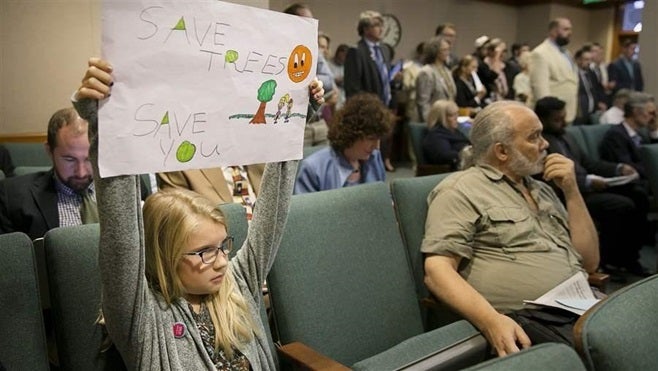Will the recent tangle over the regulation of trees on private land in Texas spread to other cities and states?

Jayden Malone holds up a sign during a hearing at the Texas Capitol in July on a bill that would have given private property owners complete control over the trees on their land. Texas lawmakers rejected the proposal, but it has spurred fears of a backlash against local tree ordinances.
By Mindy Fetterman
AUSTIN, Texas — Cities have long regulated what can be done to trees in parks, along public streets or on government property, deciding when they can be trimmed, treated for disease or removed.
In recent years an increasing number of cities also have started regulating what happens to trees on private property — on land owned by either developers or homeowners, including trees in their yards. Faced with booming populations, these cities are treating trees as a key part of urban planning and green infrastructure. The idea is that even trees on private property serve the public good by soaking up stormwater, filtering water for lakes and rivers, cleaning the air and cooling buildings to cut down on energy consumption.
But a recent tangle over the regulation of trees on private land in Texas has some urban tree advocates bracing for a backlash.
Texas Gov. Greg Abbott, a Republican, pushed state lawmakers in a recent special session to scrap cities’ tree ordinances, which he called “socialism,” in favor of a state law stipulating that any private property owner, including developers, had complete control over trees on their land. Abbott’s proposal would have overruled laws regulating trees on private property in about a hundred cities across the state, including Austin.
“The question comes down to who owns the tree, whose tree is it, and what does it mean to own something?” said Bryan Mathew, a policy analyst with the Center for Local Governance at the Texas Public Policy Foundation, a conservative research group that supported Abbott’s legislation. “We’re moving more and more into a ‘nanny state’ where we think experts should make the best decisions for us.”
Abbott’s measure died in the Legislature, though lawmakers did offset the fees that cities can charge property owners for removing a tree if they plant new ones on their land.
“What looked like a tsunami coming at us was not the storm we thought it would be,” said Keith Mars, Austin’s city arborist. The legislation ended up “nowhere near as bad as we thought it might be.”
Nevertheless, tree advocates are worried. “If this kind of behavior were to take root, it would be disastrous,” said Larry Wiseman, former president and CEO of the American Forest Foundation, a nonprofit that advocates for urban trees. “It’s mind-boggling.”
‘Growth Industry’
Regulating what happens to trees on private property has been “a real growth industry” over the past 10 to 15 years, and the trend is accelerating, said Pete Smith, urban forest program manager for the Arbor Day Foundation, a nonprofit that advocates for planting trees. “It’s a natural byproduct of the urbanization of America.”
More cities are treating trees as part of “green infrastructure” and are devising urban forest master plans to protect trees — specifically, older trees.
There are no databases tracking how many states are adopting legislation to restrict trees on private property, said Paul Ries, a professor of urban forestry at Oregon State University. “But anecdotally, yes. We are seeing more private tree ordinances.”
That’s because city-owned trees represent only 15 to 20 percent of a metropolitan area’s tree population, he said. And if you want to protect trees and the tree canopy of a region, “you have to look at private trees.”
Austin has long had among the nation’s most restrictive rules governing private trees.
No tree wider than 19 inches in diameter can be removed on private property without the city’s approval, and homeowners or developers have to replace the tree with enough trees to produce similar shade. For instance, to remove a 20-inch tree, a developer would have to plant 10 trees with 2-inch diameters. It also doesn’t allow “heritage trees,” which it defines as 24 inches in diameter or wider, to be removed on private property unless dead or diseased, without city approval.
In 2016, Washington, D.C., approved its own stringent tree rules. The city established a new heritage-tree designation for old trees whose trunks have a diameter of 32 inches or more. They can never be removed unless they are dead or diseased, including those on private property.
It also lowered the threshold for “special trees” that can be removed only with city permission to a diameter of 14 inches, down from 18 inches. That covers many younger trees, and means that about three-quarters of all trees in the district are protected. The law also established a fund from tree removal fees to pay for new trees. (The city doesn’t control trees on federal lands, though.)
“Trees, whether on public or private property, contribute to the livability of the city,” said Earl Eutsler, the district’s associate director for urban forestry. Protecting “green infrastructure” is as important as maintaining roads, bridges and airports, he said.
Atlanta may move in a similar direction. A new urban design team made up of city representatives and outside consultants is launching a project to rethink the city’s development for a population that is expected to triple to 1.2 million in the next 25 years, said Tim Keane, commissioner of the department of city planning. That overall design will result in several new regulations, including new tree ordinances, he said.
Currently, private landowners can remove trees and pay a fine, which the city uses to pay for planting new trees. But “the ordinance is not built around saving trees,” Keane said. “At the end of the day, they don’t save trees; people just write a check.”
Any new rules would likely include regulating trees on private property, he said.
“Trees would become one of the critical design parameters that people have to work around” when developing or building on private property, Keane said. “We’d identify the size and species that you could not remove in any circumstances [except disease and death]. They’d have to be protected.”
The “transaction” around trees would change to “protecting trees, not generating a fund,” he said.
‘Opening Salvo’
Taking on the regulation of trees on private property was “an opening salvo” in a larger strategy to fight restrictions on other uses of private property, like commercial zoning laws, said Mathew of the Texas Public Policy Foundation. “The tree issue was a way to broaden the conversation of what private property means.”
He said the group’s philosophy on private property rights can be traced to John Locke, the 18th century philosopher, who said: “As much land as a man tills, plants, improves, cultivates, and can use the product of, so much is his property.”
Smith, of the Arbor Day Foundation, said more efforts to limit what cities can do may follow the Texas tree bill because “states want to have a firm hand on how cities regulate stuff.” The principle at stake, he said, is broader than just trees: It’s about local control vs. state control.
Christopher Thayer, an attorney in Seattle who has handled lawsuits about tree restrictions, said he thinks more efforts will be made to cut back on city regulations. “It’s a bit of a shock for people who think, ‘It’s my property, I can do what I want,’ ” he said.
And then they find out they can’t.

